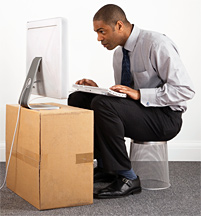Your Chair Height and Sitting Position

Attempt to maintain flat-footed placement on the floor to help with overall balance while sitting. Your objective is to maintain proper posture while sitting by allowing as much contact between your body and the chair. It is important to try to sit back in the chair as far as possible and to maintain contact with your shoulders against the back of the chair. The backs of your upper legs and your buttocks should completely contact the base of the chair.
It will also help a great deal if you learn to sit while holding in your lower abdomen for extended periods of time. This helps support the soft tissue of the lower back, which is actually under more strain in a seated position than when you are standing.
Also try to change positions from time to time; depending on your employer and type of job, you may even be able to stand up and continue working for 4-5 minutes every so often. This allows for proper circulation Some employers have offered standing workstations as an alternative to sitting for long periods of time. Research has shown that employees who work at a standing workstation for a minimum of 60 minutes per day have 70 percent less musculoskeletal complaints. (Believe it or not, there are even workstations that come complete with a treadmill, so employees can walk while they are working!)
Small Changes, Big Benefits
 It may seem like an oversimplification, but learning to sit up straight, suck your stomach and keep your keyboard at the level of your elbows and below are easy ways to minimize your risk of chronic and repetitive-stress injuries at the workplace. That's good news to you and your employer. In this high-tech world of computers, it might be worth your time to consider these common-sense approaches, instead of buying a $150 ergonomic keyboard.
It may seem like an oversimplification, but learning to sit up straight, suck your stomach and keep your keyboard at the level of your elbows and below are easy ways to minimize your risk of chronic and repetitive-stress injuries at the workplace. That's good news to you and your employer. In this high-tech world of computers, it might be worth your time to consider these common-sense approaches, instead of buying a $150 ergonomic keyboard.
Many companies have developed an ergonomic program designed to help reduce the factors associated with musculoskeletal fatigue and injury. Research has shown that workers who are compliant with these guidelines have increased productivity, efficiency, and morale. Companies have also noticed a decrease in reported injuries illnesses, workers' compensation costs, sick days and employee turnover. The bottom line is that neither you nor your company can afford to sit back (no pun intended) while you practice poor workspace habits and increase your risk for injury. And remember that these ergonomic safety tips also apply to the home, where most people now have computers as well.
Carpal Tunnel Syndrome: Not Just for Computer Users Anymore
 Carpal tunnel syndrome (CTS) is a common condition associated with repetitive tasks such as computer keyboard use. But what if you don't work on a computer much and are still experiencing wrist and hand pain symptomatic of CTS? Recent research suggests a more reliable source of the problem, albeit also related to positioning: improper sleep position. Most people who sleep in the fetal position (curled up on one side) sleep with their wrists in a fully flexed position (bent backwards under their chin, resting next to their chest). This can cause pressure that ultimately leads to CTS. The most common orthopedic test for CTS is called Phalen's test. Flex both wrists fully and place the back of your hands firmly against each other; an increase of pain in the wrist and/or hand is considered a positive test. Talk to your doctor for more information.
Carpal tunnel syndrome (CTS) is a common condition associated with repetitive tasks such as computer keyboard use. But what if you don't work on a computer much and are still experiencing wrist and hand pain symptomatic of CTS? Recent research suggests a more reliable source of the problem, albeit also related to positioning: improper sleep position. Most people who sleep in the fetal position (curled up on one side) sleep with their wrists in a fully flexed position (bent backwards under their chin, resting next to their chest). This can cause pressure that ultimately leads to CTS. The most common orthopedic test for CTS is called Phalen's test. Flex both wrists fully and place the back of your hands firmly against each other; an increase of pain in the wrist and/or hand is considered a positive test. Talk to your doctor for more information.
David Ryan, BS, DC, a former two-sport professional athlete with more than 20 years in the health care field, is on the editorial review board of Muscle & Fitness magazine and is a chief feature writer for BodyBuilding.com. He has been the medical director and co-chairman of the Arnold [Schwarzenegger] Sports Festival since 1997.

